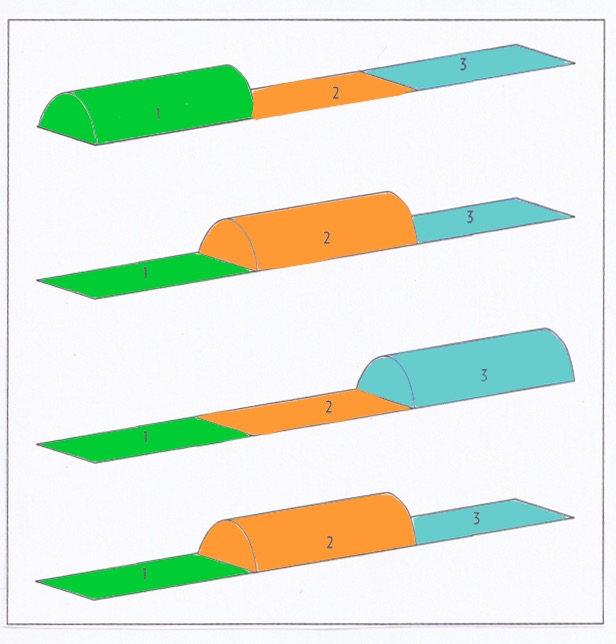Rolling High Tunnel Greenhouse Project
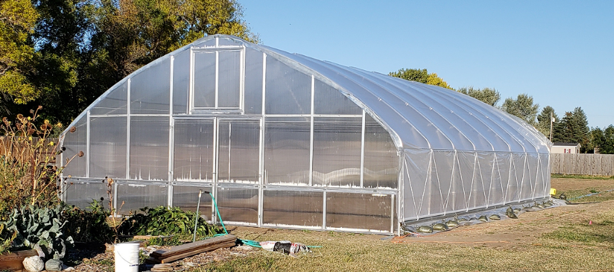
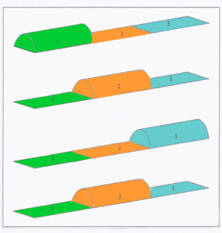
The Rolling High Tunnel is a unique mobile greenhouse that can move on a track into 3 or more positions.
It features a high dome for maximum space and circulation. Its capacity for movement allows working, freshening, and double-digging the soil with ease to enhance fertility; helps with controlling insect infestation; and accommodates a variety of plants with different needs for protection from start to establishment or harvest.
An example of this is starting an early crop of lettuce in position 1; as spring weather warms, the ends can be raised.
We move into position 2 for tomato transplants.
In position 3, hot-weather sun-loving herbs and vegetables are fully exposed while species like cucumbers and melons are inside.
At the end of the season, we move back to position 2 to protect the tomatoes, and then finally, back to position 1 to plant a late celery crop after the lettuce is harvested… and after the celery, we begin again with early lettuce.
Update
We continue to harvest greens and other vegetables from PPI’s rolling high tunnel greenhouse. We harvested 5.5 lbs of greens from the RHT on Dec. 5: red leaf lettuce, Romaine, arugula, and spinach. The most we harvested in one day was over 13 lbs of greens!
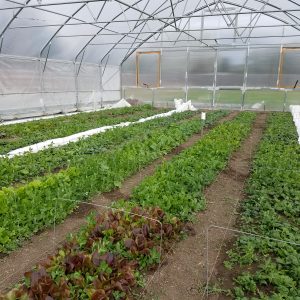
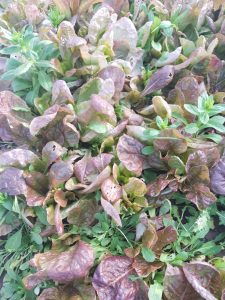
Background
With the help of generous donors and grant funding from Park County Community Foundation, The Beim Foundation, and NRCS-USDA, the PPI Rolling High Tunnel was completed in late 2018. We held an open house and tour on May 4, 2019, and many plants are now growing in the greenhouse. Look for more updates as the season progresses!.
Thank you to all who donated to our campaign for the rolling high tunnel greenhouse project. Please see below for information about the RHT, and why it is an important educational resource for creating abundant foodscapes in cold-climate regions.
Why should you care?
Our goal for the Paradise Permaculture Institute RHT greenhouse project is to incorporate planting in polycultures and food forests for many levels of diversity, and to create sustainable foodscapes for seven generations into the future.
How would you like a wealth of nutritious food growing right outside your own back door in a resilient, sustainable landscape?
Growing food using gardening principles patterned after nature’s growing strengths is less work for you and results in a higher yield of nutrient-dense food. This can be done on any scale, from back yard to small or large farm.
The diversity of polyculture–planting in groupings–allows more successful harvests for everyone. Many polycultures (“guilds”) put together can form a food forest (ground cover, herbs, plants, shrubs, small or large fruit and nut trees) that keeps the soil quality intact and encourages beneficial insects. Planting a food forest from the canopy down to the ground cover creates abundance, nutritious food, and more capacity to store water and trap carbon to restore the balance of the earth.
Through observing and learning from nature to consider the plants’ needs, it is possible to consciously choose plants that will support each other’s growth, adapt to a specific bioregion, and be more productive. Food grown in cold climate regions tends to be nutrient-dense because of the cold and the short growing season. We desire to introduce species suited to our bioregion, and to bring back hard-to-find edible native plants.
The purpose of the Paradise Permaculture Institute Rolling High Tunnel Greenhouse Project
This project will help us solve the particular challenges of short growing season in a windy cold climate. The Rolling High Tunnel Greenhouse will be an important educational tool for PPI to share knowledge with farmers, gardeners and students, allowing us to grow a variety of plants more effectively and efficiently by extending the growing season on both ends. We plan to create a propagation environment to use in our classes and Transition Gardens, and then share our results with the community and other local nurseries.
A specific educational objective will be to demonstrate a sustainable closed-loop food production cycle: grow / harvest food / harvest seeds / plant seeds / grow again; and to offer classes on how to prepare the plants for use in nutritious meals, shakes, and natural remedies. We believe that children will enjoy the hands-on experience of smelling and touching the plants, so we will provide various educational opportunities to involve children from the community in planting and harvesting.
We have found that many of the plants we would like to teach about, grow and use in local gardens are expensive and some have to be specially ordered because people aren’t propagating them locally. Mimicking nature’s diversity when planting, bringing back some native species, and planting for our cold growing climate will allow us to create foodscapes capable of producing abundance for many generations to come, with less work from us. The frustration of not having certain plants on hand, and the realization that some people don’t have the funds to purchase the plant they require for their yards, led to our decision to propagate them at PPI.
An example of a species that is not currently easy to find in our region but is perfectly adapted for similar cold climates is the Siberian Pine. In only 5-8 years it can produce an abundance of highly nutritious, delicious pine nuts. By propagating a range of selected non-native and native species in the ground or in containers on rolling benches, our nursery operation can become self-sustaining within a few years as we make these plants available for purchase.
The Rolling High Tunnel is a unique mobile greenhouse that can move on a track into 3 or more positions. It features a high dome for maximum space and circulation. Its capacity for movement allows working, freshening, and double-digging the soil with ease to enhance fertility; helps with controlling insect infestation; and accommodates a variety of plants with different needs for protection from start to establishment or harvest. An example of this is starting an early crop of lettuce in position 1; as spring weather warms, the ends can be raised. We move into position 2 for tomato transplants. In position 3, hot-weather sun-loving herbs and vegetables are fully exposed while species like cucumbers and melons are inside. At the end of the season, we move back to position 2 to protect the tomatoes, and then finally, back to position 1 to plant a late celery crop after the lettuce is harvested… and after the celery, we begin again with early lettuce.
